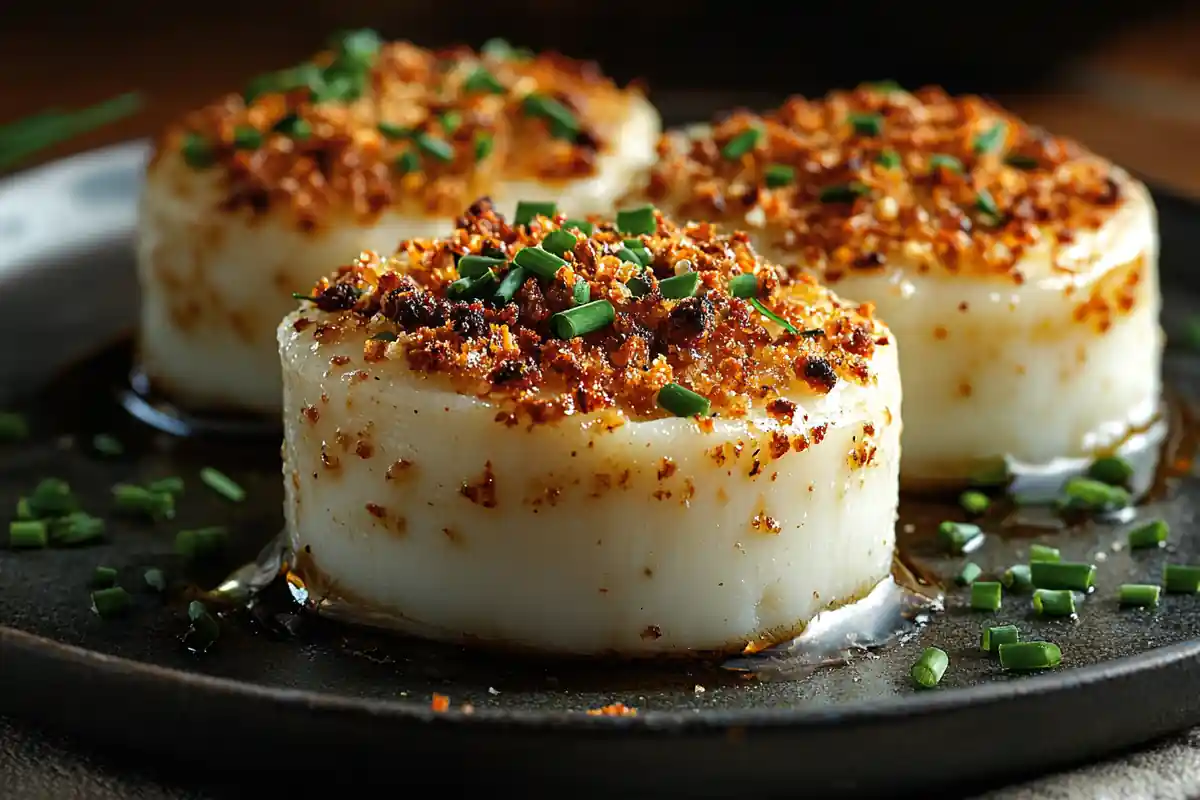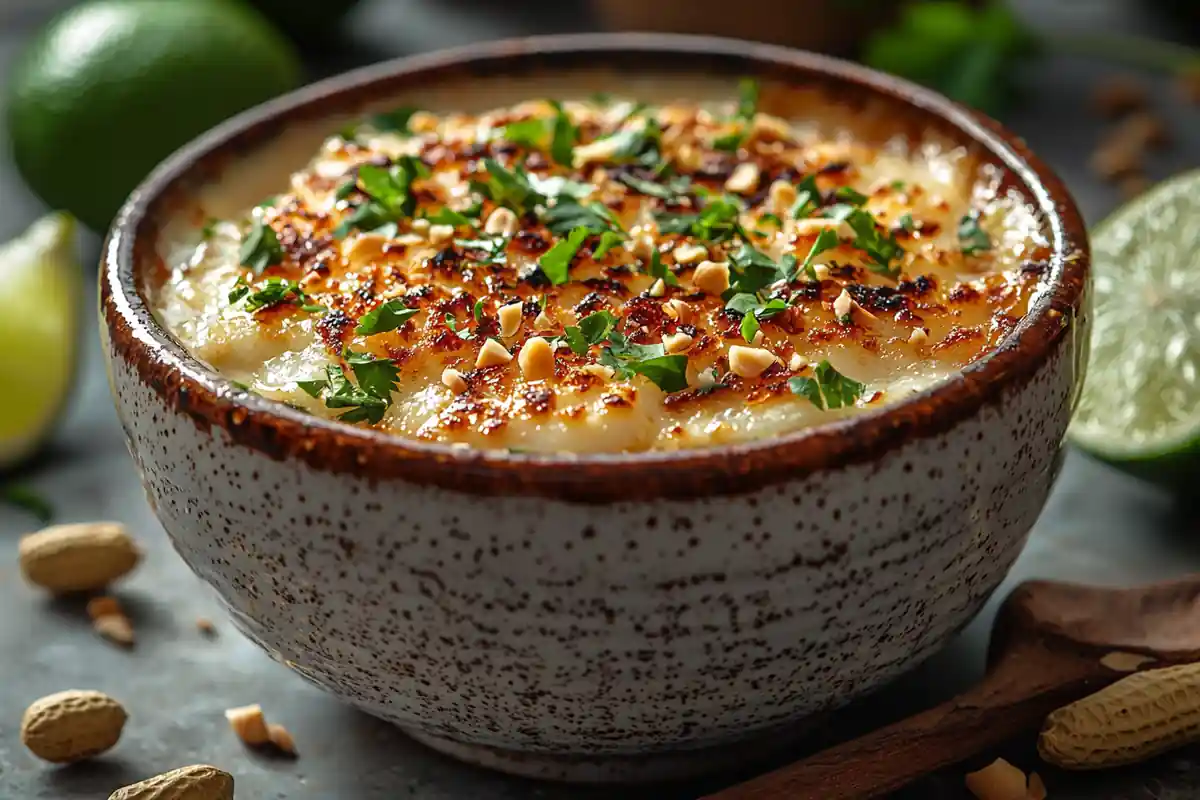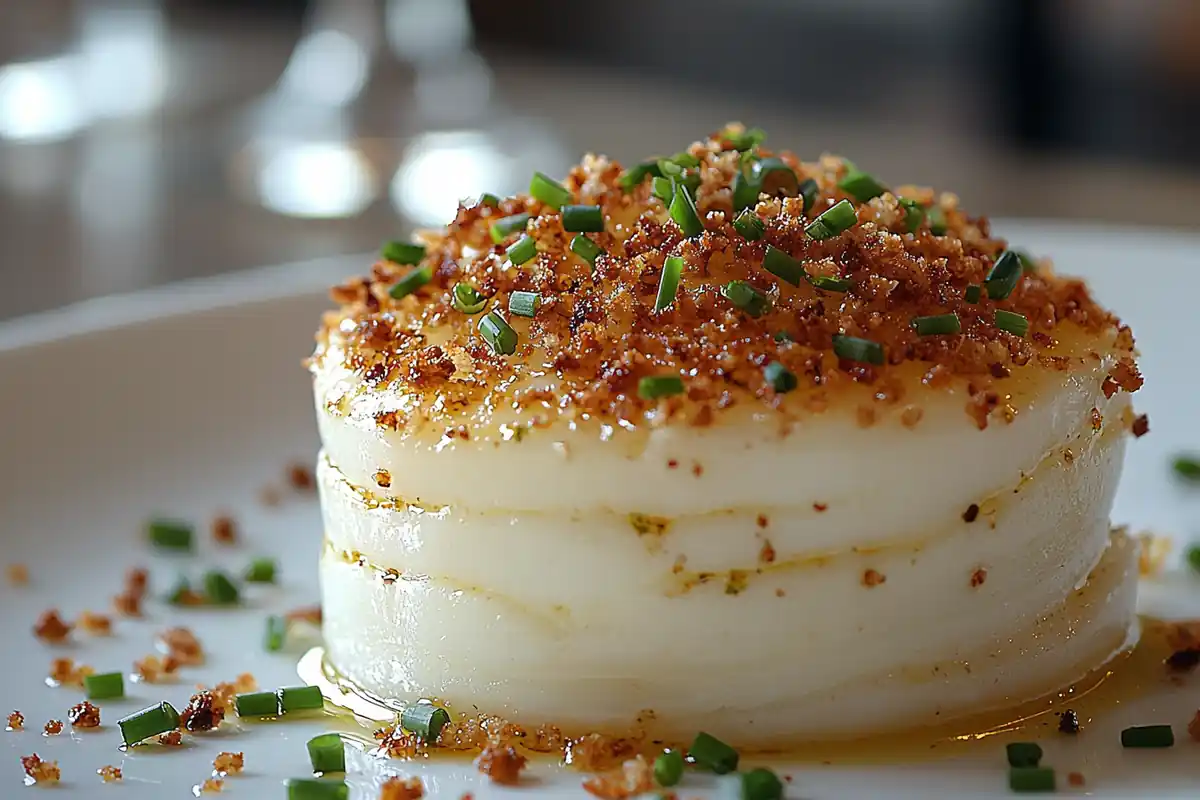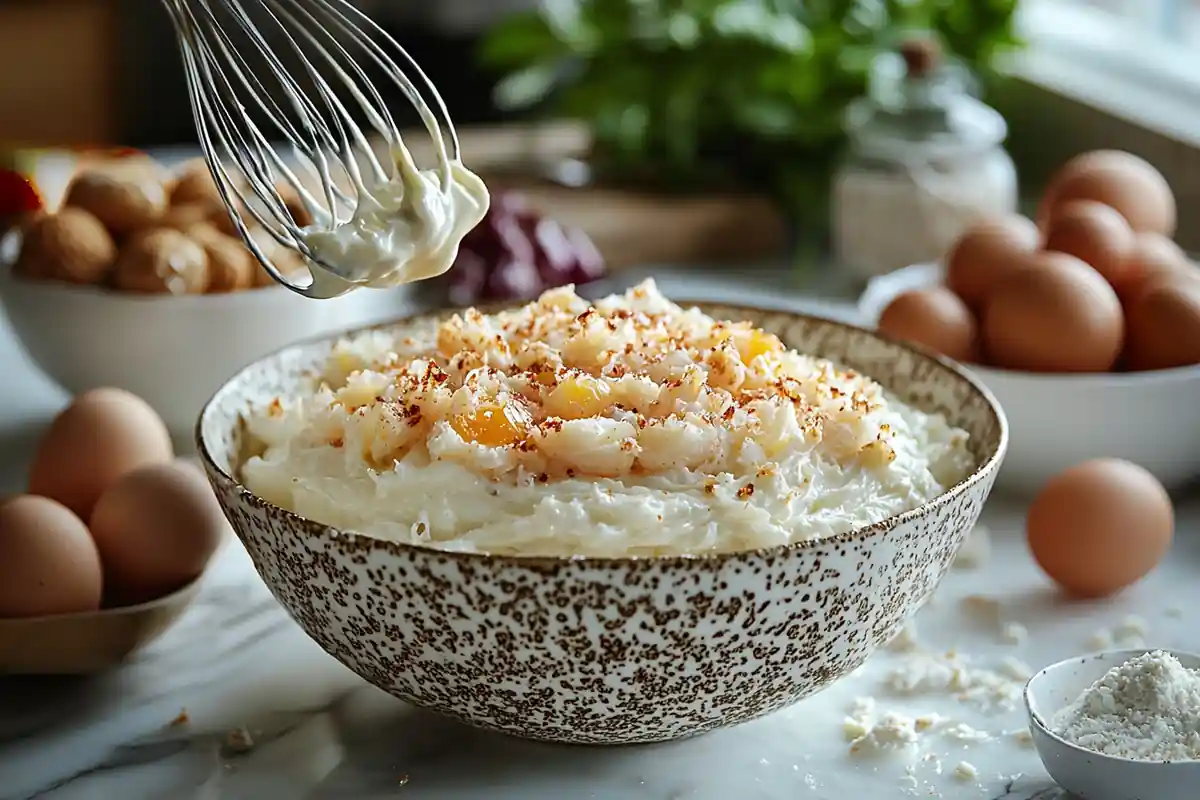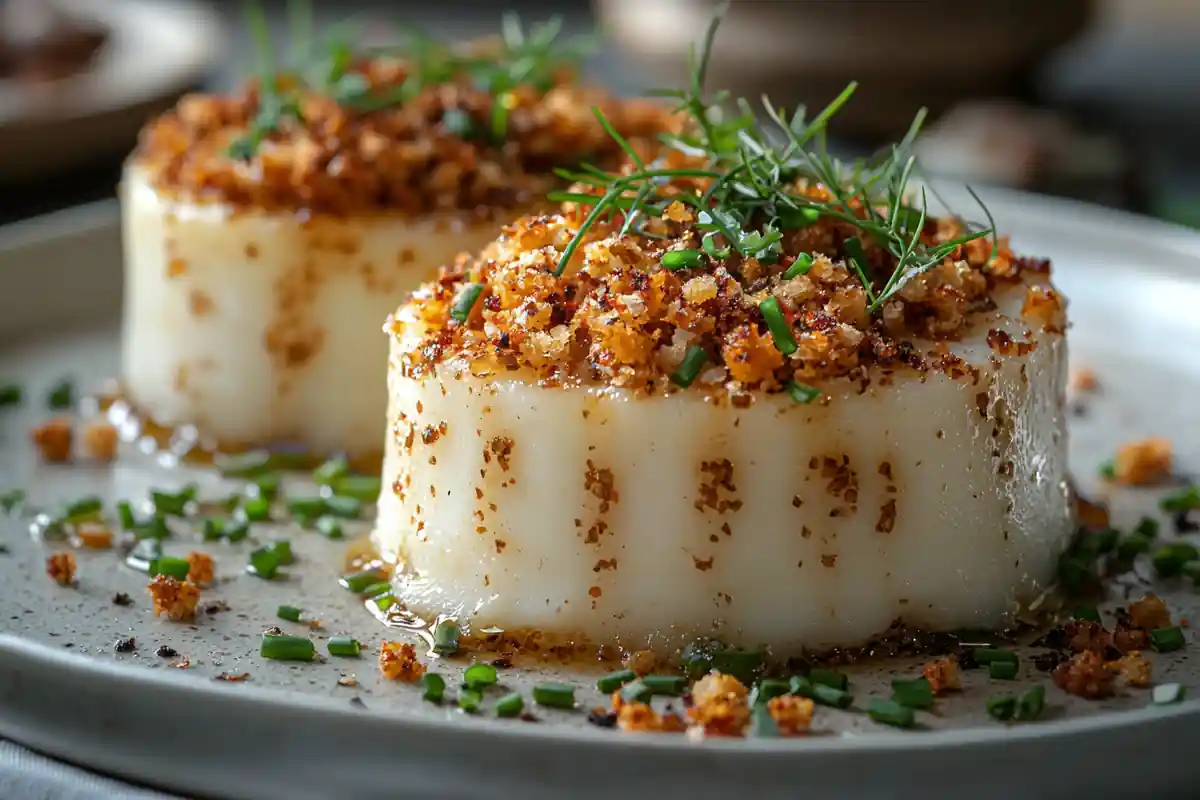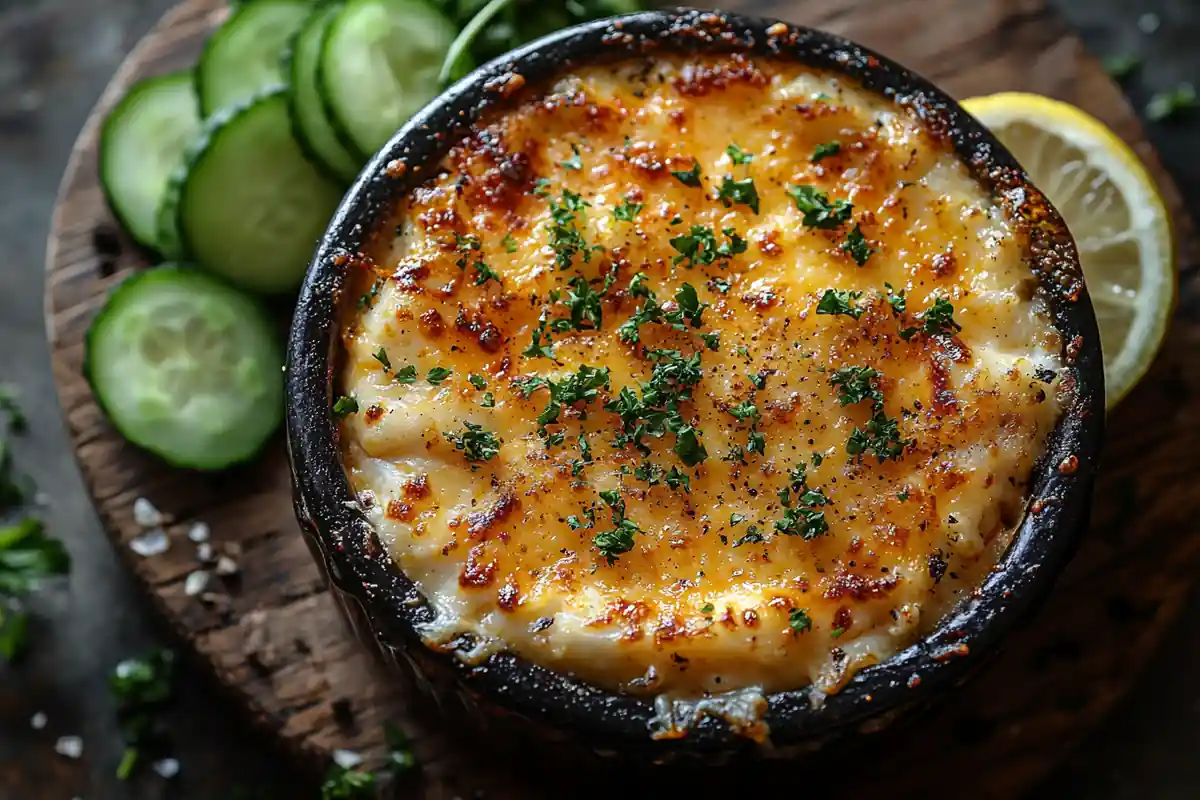Introduction
If you’ve only ever known crème brûlée as a sweet treat, then you’re in for a delightful surprise. This savory spin—crab brulee—blends the lusciousness of creamy custard with the bold, ocean-kissed flavor of crab. It’s where elegance meets umami, and every bite offers a perfect contrast of velvety smoothness and a crisp brûléed topping.
In this ultimate guide, we’ll walk you through how to make crab brulee recipe at home—from ingredients and kitchen tools to expert cooking techniques. We’ll also share delicious variations, storage tips, and answers to the most curious foodie questions.
What Is a Crab Brulee Recipe?
Surprising, refined, and packed with flavor, the crab brulee recipe is a savory cousin of the classic French dessert. Instead of sugar, you’ll find bold seafood flavors, creamy egg custard, and just the right amount of crunch on top.
A Culinary Twist on Tradition
Traditionally, crème brûlée is sweet. But this inventive dish switches sugar for umami-rich ingredients like crab, cream, and egg yolks. It’s broiled just until the top caramelizes (usually with cheese or breadcrumbs), creating that signature crack.
Crab brulee is both a conversation starter and a flavor bomb, often served in ramekins as an appetizer at upscale restaurants or elegant dinner parties. But trust us—once you know how easy it is, you’ll want to make it at home.
The Rise of Savory Brulees
Savory custards have been sneaking their way into modern cuisine. Think lobster flan, foie gras crème, and of course, savory seafood brûlées. These dishes flip expectations, challenging your palate while offering refined textures and tastes.
One popular culinary trend even adds wasabi or truffle oil to these creations—pushing the boundaries of what brûlée can be.
Why Crab Is the Star of the Show
Crab meat—especially fresh, lump crab—is naturally sweet, tender, and luxurious. It’s the perfect match for a silky base and complements creamy elements without overpowering them. Plus, it balances beautifully with spices and herbs like chives, cayenne, and lemon zest.
And unlike some other seafood, crab has a mild profile that works well in custards. It absorbs flavor without becoming fishy. When gently folded into an egg-and-cream base, it transforms into a gourmet masterpiece.
Crab Brulee Around the World
You might see crab custard brûlée on tasting menus from Tokyo to Paris, but every chef adds their twist. In Asia, it might come with soy and ginger. In the Mediterranean, you’ll find hints of oregano or even saffron. Stateside? Expect bold additions like chipotle or Old Bay.
Want to see an advanced seafood brûlée technique? We recommend browsing the MasterClass guide to culinary techniques to see how professional chefs layer flavor in custard dishes.
A Recipe Worth Repeating
So whether you’re a foodie, home chef, or just curious about savory sweets, this recipe might just become your new favorite appetizer. And guess what? You don’t need a culinary degree—or even a torch—to nail it.
From here on, we’re diving spoon-first into the crab brulee recipe creation process.
Essential Ingredients for the Perfect Crab Brulee Recipe
Crafting the perfect crab brulee recipe starts with selecting fresh, high-quality ingredients that come together to form that creamy, savory magic. While this dish might sound like a challenge, the truth is—it’s all about balance. Each component has a role to play, and when they work in harmony? It’s culinary symphony time.
Fresh Crab Meat vs. Imitation Crab
Let’s not crab-walk around it—real crab meat makes all the difference.
-
Lump crab meat: The gold standard. It’s juicy, sweet, and holds shape beautifully.
-
Claw meat: Slightly stronger flavor and a bit more affordable.
-
Imitation crab: While convenient, it lacks the richness and natural sweetness of the real deal. Use only if necessary.
Tip: If using canned crab, drain well and pat dry. You don’t want any excess moisture ruining the custard texture.
The Creamy Base: Eggs, Cream, and Cheese
Ah, the custard core. This is where the magic really happens.
-
Heavy cream: Gives that luscious texture. Want a lighter version? Sub with half-and-half, but expect a slightly thinner result.
-
Egg yolks: Crucial for thickening and richness. Don’t skip!
-
Parmesan or Gruyère cheese: Adds a subtle bite and browns beautifully under the broiler.
You can also sprinkle a touch of nutmeg or paprika for a warm aroma—totally optional, but highly recommended.
Seasonings & Flavor Enhancers
This is where the personality of your savory crab brulee comes through. Keep it elegant, but bold.
Here’s what to toss in:
-
A pinch of sea salt and cracked pepper
-
Fresh chives or scallions, finely chopped
-
A whisper of lemon zest for brightness
-
Optional: minced garlic, a hint of dijon mustard, or a dash of Old Bay seasoning for extra zing
Brulee Topping Alternatives
Traditionally, sweet brûlées get a sugar crust. But here? We do things differently.
-
Grated cheese topping: Think Parmesan or Gruyère for a golden finish.
-
Breadcrumbs + butter mix: Toasty, crunchy, and gives contrast.
-
Toasted panko: For a light, crispy texture.
Want to try what the pros do? Head over to Serious Eats for sous-vide variations and custard consistency tips from top chefs.
🧾 Full Ingredient List for Crab Brulee Recipe
-
1 cup lump crab meat (fresh or canned, well-drained)
-
1 ¼ cups heavy cream
-
4 large egg yolks
-
½ cup finely grated Parmesan cheese
-
1 tablespoon chopped chives
-
½ teaspoon lemon zest
-
¼ teaspoon salt
-
¼ teaspoon black pepper
-
Optional: ½ teaspoon Old Bay seasoning or a dash of paprika
-
¼ cup grated cheese or buttered breadcrumbs (for topping)
🧑🍳 Cooking Instructions: Step-by-Step
Prep Like a Pro
-
Preheat your oven to 325°F (165°C).
-
Lightly grease 4 ramekins and place them in a baking dish.
Make the Custard
-
In a saucepan, warm the cream over medium heat—just until it simmers. Don’t boil.
-
In a mixing bowl, whisk egg yolks, salt, pepper, and cheese until smooth.
-
Slowly drizzle the hot cream into the egg mixture, whisking constantly to temper.
Add the Flavor
-
Gently fold in the crab meat, chives, and lemon zest.
-
Pour the mixture evenly into ramekins.
Bake It Right
-
Fill the baking dish with hot water halfway up the sides of the ramekins.
-
Bake for 30–35 minutes or until the custard is set but still slightly wobbly in the center.
Finish with the Brulee
-
Let cool slightly, then top with grated cheese or breadcrumbs.
-
Broil for 1–2 minutes or use a kitchen torch to create a golden crust.
Serve warm, with a small side salad or as a standalone showstopper!
🥗 Nutritional Content (per 100g)
| Nutrient | Amount |
|---|---|
| Calories | 185 kcal |
| Protein | 9 g |
| Fat | 14 g |
| Carbohydrates | 4 g |
| Cholesterol | 135 mg |
| Sodium | 310 mg |
Kitchen Tools for Making Crab Brulee at Home
You don’t need a professional chef’s kitchen to whip up a savory crab brulee recipe. But hey, having the right tools? That’ll make all the difference between a lumpy disaster and a smooth, silky showstopper.
Let’s break down what you’ll need—and why each piece matters.
Ramekins: Small Vessels, Big Impact
If this dish had a throne, it’d be the ramekin.
These small, ceramic cups hold the custard in place while helping distribute heat evenly. They’re oven-safe, stylish, and make serving effortless.
-
Best size: 6-ounce ramekins
-
Quantity: This recipe makes 4 servings, so keep at least 4 on hand
Don’t have ramekins? Small mason jars or oven-safe teacups can work in a pinch—but ramekins deliver the most reliable results.
Hot Water Bath (Bain-Marie)
Want that luxuriously creamy texture? A hot water bath is the secret.
-
It prevents curdling
-
Distributes heat evenly
-
Helps the custard set without cracking or drying
Use a baking dish or deep roasting pan. Carefully pour hot water halfway up the sides of your ramekins—this keeps the temp gentle and stable throughout baking.
Mixing Bowls & Whisk
Sounds basic, but these tools are crucial.
-
Large mixing bowl: Needed for whisking egg yolks and cream
-
Balloon whisk: Helps aerate the mixture slightly without overbeating
Avoid using electric mixers for this one. We’re not whipping—just gently combining.
Fine Mesh Strainer (Optional but Golden)
For restaurant-quality texture, strain the custard mix before pouring it into ramekins. This catches any cooked egg bits and delivers that ultra-smooth mouthfeel.
You’ll be amazed at how much silkier your crab custard base turns out.
Kitchen Torch or Broiler
For that irresistible golden crust on top, you’ve got two choices:
-
Kitchen torch: Offers precise control—ideal for melting cheese or browning breadcrumbs evenly
-
Broiler: A great backup if you don’t own a torch. Just watch it like a hawk to avoid burning
Want to see how chefs perfect their brûlée crusts? This MasterClass culinary guide offers top-tier tips for using torches safely and effectively.
Tongs, Towels & Trays
Here’s the behind-the-scenes gear that makes the magic easier:
-
Tongs or silicone gloves: For removing ramekins safely from the hot water bath
-
Dish towel or paper towel: To gently dry ramekins before broiling
-
Wire rack: To let the ramekins cool evenly before adding toppings
Optional Upgrades for the Passionate Home Chef
Want to level up?
-
Sous vide machine: Guarantees exact custard temp every time. Serious Eats explains the science behind precision cooking.
-
Digital thermometer: Ensures the center of your brûlée doesn’t overcook (aim for ~170°F or 76°C)
So now, with your kitchen prepped like a pro’s and your tools ready, we’re all set to move into the heart of the dish: assembling and baking the ultimate crab brulee.
How to Make Crab Brulee Recipe from Scratch
Ready to whip up a crab brulee recipe that’ll knock socks off? Well, you’re about to. In this section, we’ll walk through every step—slowly and clearly—so even if you’re not a kitchen wizard, you’ll still crush it like a pro.
Whether you’re making this dish for a holiday, a fancy dinner, or just to flex your culinary creativity, this step-by-step process will guide you all the way from prep to plating.
Step-by-Step Preparation Instructions
Let’s break this down into easy, digestible actions. No rushing. Just flow.
Step 1: Preheat and Prep the Oven
Before you do anything else, preheat your oven to 325°F (165°C).
Place 4 ramekins into a deep baking dish. We’re creating a water bath soon, so make sure the baking dish has tall enough sides.
Step 2: Gently Warm the Cream
In a medium saucepan, pour in 1¼ cups of heavy cream.
Set the heat to medium-low and gently warm it until it begins to barely simmer. You’ll see tiny bubbles forming along the edges—but do not let it boil.
Once warm, remove it from the heat.
Step 3: Whisk the Yolks and Seasonings
In a separate bowl:
-
Add 4 large egg yolks
-
Sprinkle in ¼ teaspoon salt, ¼ teaspoon black pepper, and ½ cup of grated Parmesan
-
Whisk it all together until smooth
This is the foundation of your custard, so whisk with love—but not aggression. You want it velvety, not foamy.
Step 4: Tempering the Eggs (The Fancy Part)
Here comes a delicate move: tempering.
Slowly add a small amount of the warm cream into the yolk mixture while whisking constantly. This gradually raises the temperature without scrambling the eggs.
Keep whisking and gradually pour in the rest of the cream until fully combined.
Step 5: Add the Crab and Flavor Enhancers
Now, fold in:
-
1 cup of lump crab meat (drained and patted dry)
-
1 tablespoon finely chopped chives
-
½ teaspoon lemon zest
-
Optional: A pinch of Old Bay or paprika for boldness
Use a spatula to gently stir, preserving the delicate crab chunks.
Step 6: Strain and Pour
Want that smooth, five-star texture?
Pour the mixture through a fine mesh strainer into a clean bowl. This removes any egg solids and gives a silky custard finish.
Next, carefully pour the strained mixture into your ramekins—dividing evenly.
Step 7: Bake in a Water Bath
Boil a kettle of water. Then pour hot water into the baking dish until it reaches halfway up the ramekins.
Place it carefully into the oven and bake for 30 to 35 minutes, or until the edges are set and the center has a gentle jiggle.
Test by lightly tapping a ramekin—it should tremble slightly but not be liquid.
Step 8: Cool, Chill, and Brulee
Once baked, remove the ramekins from the water using tongs. Place them on a wire rack to cool for 10 minutes.
Then, refrigerate for at least 2 hours. This lets the flavors deepen and the texture firm up.
Before serving, sprinkle each with:
-
A thin layer of Parmesan cheese, or
-
A mix of breadcrumbs and a dot of butter
Use a kitchen torch or place under a hot broiler for 1–2 minutes to crisp the top until golden and slightly bubbly.
Voilà! You’ve just made a gourmet crab brulee that’s creamy, savory, and has that oh-so-satisfying brûléed top.
Serving Suggestions
Serve it warm or room-temp as a starter, alongside:
-
A small herb salad
-
Cucumber ribbons with dill
-
Toasted sourdough crisps
And here’s a pro tip: This dish pairs beautifully with citrusy, non-alcoholic beverages to balance the richness.
Looking for more elegant seafood appetizers? Check this post on seafood ramekin recipes for creative ways to use ramekins in starters.
Expert Tips for a Foolproof Crab Brulee Recipe
You’ve followed the recipe, gathered your ingredients, and nailed the custard. But here’s the deal—even the most confident home chefs can run into a few bumps when it comes to making the perfect crab brulee recipe. That’s why we’re dishing out chef-level tips and troubleshooting tricks to guarantee silky, savory success.
If you’ve ever struggled with curdled eggs, soggy bottoms, or a bland custard, don’t worry. These insights will help you fix the fumbles before they even happen.
Avoid Overcooked Eggs with Gentle Baking
One of the biggest mistakes? Cooking the custard too quickly or at too high a temp.
-
Tip: Always use a low oven temp—325°F (165°C) is ideal.
-
Use a water bath (bain-marie) to evenly cook the custard and protect the edges from overcooking.
-
If you notice bubbles on the surface, that’s a sign the oven is too hot. Lower it next time.
Pro Tip: Remove the ramekins as soon as the center gently jiggles. If it’s fully firm, it’s probably overdone.
Preventing a Runny Center
Let’s say your custard looks perfect… until you take that first bite and realize it’s too wet inside.
Here’s how to avoid that soggy situation:
-
Use fresh crab: Excess moisture from canned crab can ruin consistency. If using canned, always pat it dry.
-
Strain your custard mix: This removes egg clumps and helps the custard firm evenly.
-
Don’t skip chilling: Two hours in the fridge lets the custard stabilize and fully set.
Also, always give it that slight jiggle test. The middle should tremble like jelly—not pour out like soup.
How to Get the Perfect Brulee Crust
Now comes the moment of truth: the crispy top. If your topping burns or turns into a soggy mess, here’s how to fix it:
-
Use dry cheese or breadcrumbs: Moist toppings won’t brown well. Parmesan or panko works wonders.
-
Torch it just before serving: Don’t brûlée in advance—moisture from the custard can soften the crust.
-
Keep it close, but not too close: If using a broiler, keep ramekins 3-4 inches below the heat source and watch closely.
Want more tips from the pros? MasterClass has excellent lessons on using torches and broilers with precision.
Choose Your Texture Adventure
Not all brûlées are created equal—some chefs prefer them firm, while others like them ultra-creamy.
-
For firmer custard: Add an extra yolk and bake 5 minutes longer.
-
For silkier texture: Use only 3 yolks and slightly reduce the bake time.
This way, you can tailor the crab brulee to your exact liking.
Quick Fixes for Common Mistakes
| Problem | Likely Cause | How to Fix It |
|---|---|---|
| Watery custard | Undercooked or wet crab | Bake longer and dry crab properly |
| Curdled texture | Oven too hot or overbaked | Lower temp, use water bath |
| Bland flavor | Not enough seasoning | Add herbs, spices, lemon zest |
| Crust won’t brown | Wet topping or broiler too low | Use drier cheese and higher heat |
Chef’s Secret: Use Aromatics Carefully
Yes, garlic and onion can add flavor—but too much can overpower the delicate crab. Go light, or stick with herbs like chive, dill, or parsley to keep it balanced.
Also, avoid aggressive spices unless you’re doing a bold regional variation (like Cajun or Thai). Sometimes, less is more.
With these expert tips, your next crab brulee recipe will be nothing short of restaurant-worthy. From texture tweaks to topping tricks, it’s all about those small decisions that lead to big flavor.
Unique Crab Brulee Recipe Variations to Try
Sure, the classic crab brulee recipe is already a showstopper—but why stop there? This dish is incredibly versatile. Whether you’re in the mood for a spicy kick, an herby twist, or a global culinary experience, there’s a flavor path for every palate.
Below are some inventive, crowd-pleasing variations that build on the savory custard foundation and dial up the wow factor.
Cajun-Style Crab Brulee
If you want bold Southern flair, this variation brings heat and smoky depth. Cajun seasoning, with its paprika, cayenne, and garlic notes, transforms the dish into a spicy, comfort-food version of fine dining.
To do it:
-
Add ½ tsp Cajun seasoning to the custard base
-
Mix in 1 tsp finely chopped bell pepper
-
Top with a cheddar-parmesan mix for extra bite
It pairs well with a crisp cucumber salad or roasted corn spoonbread.
For Southern seafood inspiration, see how Serious Eats layers Cajun flavors in creamy seafood dishes.
Asian-Inspired Wasabi Crab Brulee
This version brings Japanese flavors to the spotlight. Wasabi adds a gentle nose-tingling heat, while soy sauce lends that irresistible umami.
To do it:
-
Add ¼ tsp wasabi paste and ½ tsp low-sodium soy sauce to the cream before heating
-
Fold in a few toasted sesame seeds for nutty crunch
-
Garnish with shredded nori and a thin slice of pickled ginger
Serve it with cucumber ribbons and miso soup for a fusion bento-style starter.
Mediterranean Crab Brulee with Herbs
Think sun-drenched coastlines, fresh herbs, and breezy flavors. This version is light, aromatic, and perfect for spring brunches or garden parties.
To do it:
-
Replace chives with finely chopped fresh oregano and thyme
-
Add a touch of crumbled feta cheese to the custard
-
Top with breadcrumbs mixed with olive oil and lemon zest
It’s the type of dish that begs to be enjoyed with crusty bread and juicy tomatoes on the side (skip the wine, though—we’re keeping it clean).
Smoky Chipotle Crab Brulee
For those who crave a little fire and smoke, chipotle is your go-to. It adds both warmth and depth without overwhelming the crab.
To do it:
-
Add ¼ tsp chipotle powder to the yolk mixture
-
Blend in a teaspoon of roasted corn kernels for sweetness
-
Top with a blend of Monterey Jack and Parmesan
Garnish with micro cilantro, and you’ve got a dish that feels like modern Tex-Mex meets French technique.
Thai Coconut Crab Brulee
Silky coconut milk and aromatic herbs give this variation a Southeast Asian flair. It’s soothing, subtly sweet, and just exotic enough.
To do it:
-
Replace half the cream with coconut milk
-
Infuse with 1 tsp lemongrass paste and a pinch of ginger
-
Top with crushed peanuts and a hint of lime zest
Want to go the extra mile? Add a few drops of fish sauce for authentic umami punch—but tread lightly!
Herbaceous Garden-Style Brulee
If you’re a fan of herbs and veggies, this version is for you. It’s fresh, colorful, and bursting with green goodness.
To do it:
-
Fold in blanched spinach, fresh parsley, and minced green onions
-
Swap Parmesan for a blend of goat cheese and mozzarella
-
Top with a crispy mix of panko and chopped walnuts
Pair with a tomato vinaigrette salad for a total flavor bomb.
These crab brulee recipe variations are proof that with a little imagination—and the same core technique—you can take one incredible base and stretch it into a world of flavor. Customize, mix it up, and make it your own.
Up next? What to serve alongside your sizzling, creamy masterpiece.
What to Serve with Crab Brulee Recipe
Pairing your savory crab brulee with the right sides and accompaniments is more than a nice-to-have—it’s the finishing touch that takes your meal from memorable to unforgettable.
Since this rich and creamy dish is full of flavor and depth, it needs sides that balance and complement—nothing too overpowering, but definitely not boring either.
Let’s explore some of the best serving suggestions.
Elegant Starters and Side Dishes
Whether you’re serving crab brûlée as a luxe appetizer or a small main course, these light, bright sides are your best bet:
Crisp Garden Salad with Lemon Vinaigrette
Why it works: The acidic vinaigrette cuts through the richness of the custard, while fresh greens cleanse the palate.
-
Use arugula, baby spinach, or watercress
-
Add radishes, cucumbers, or shaved fennel for crunch
-
Dress with lemon juice, olive oil, a pinch of sea salt, and cracked pepper
Optional twist: Sprinkle toasted sunflower seeds or pumpkin seeds on top for texture.
Chilled Asparagus Spears or Green Beans
Blanched and lightly salted, these veggies are a refreshing contrast to the warm, creamy custard.
Serve them simply, or toss with:
-
A splash of sesame oil
-
A sprinkle of citrus zest
-
Or a drizzle of herb-infused olive oil
Keep it clean and classy—this isn’t the time for heavy sauces.
Roasted Root Vegetables or Sweet Potatoes
Want to offer a slightly heartier plate? Oven-roasted veggies like carrots, beets, and sweet potatoes add earthy sweetness to balance the crab.
Just don’t go overboard. Keep your seasoning mild—olive oil, thyme, and a touch of salt go a long way.
Mini Brioche or Herb Crackers
Serve with a side of soft brioche rolls or crispy crackers to scoop the custard or add a crunchy contrast.
Try:
-
Chive and rosemary crackers
-
Toasted baguette slices
-
Gluten-free seed crisps
These are especially helpful if your brûlée is served warm and slightly loose in texture—perfect for dipping.
Refreshing Non-Alcoholic Beverages
Instead of wine, pair your crab brulee recipe with bright, citrus-forward drinks or herb-infused sips like:
-
Sparkling lemon water with cucumber slices
-
Chilled herbal tea (like mint or lemongrass)
-
Homemade ginger-lime spritzer
These drinks elevate the experience while keeping things light and fresh.
Serving Style Ideas
Looking to wow your guests with presentation?
Try these tips:
-
Garnish the top with a tiny crab claw or a twist of lemon peel
-
Plate ramekins on rustic wooden boards with mini spoons
-
Serve alongside edible flowers or microgreens for color contrast
And if you’re building a tasting menu, consider linking this dish to a lighter seafood starter like shrimp ceviche or ending with something crisp like a citrus sorbet.
Need more ideas for seafood pairings and small-plate appetizers? Check out Nory Recipes’ seafood starters archive for internal linking inspiration and elegant seafood combinations.
How to Store and Reheat Crab Brulee
Made too much of that dreamy, creamy crab brulee recipe? No worries—you don’t have to waste a single bite. This dish may be gourmet, but it stores like a champ if you know the tricks. Whether you’re prepping ahead or saving leftovers, these storage and reheating tips will keep your brûlée as luscious and flavorful as when it first came out of the oven.
Refrigeration Tips: Short-Term Storage
Brulee is best enjoyed fresh, but it’s perfectly safe to refrigerate for a day or two—before torching the topping.
Here’s how to do it right:
-
Let ramekins cool fully to room temperature first. Never put hot ramekins directly into the fridge.
-
Cover with plastic wrap or reusable lids, but leave a tiny corner open to prevent condensation buildup.
-
Store for up to 2 days. After that, the texture can begin to separate.
Important: Don’t brûlée the top before refrigerating. The crust will go soggy. Always torch or broil just before serving.
Freezing: Is It Worth It?
While possible, freezing crab custard dishes is not ideal.
-
The texture may become grainy once thawed
-
Dairy and egg-based custards tend to separate after freezing
-
Crab meat can lose its delicate texture and become watery
Only freeze if absolutely necessary, and always do so without the topping.
If you do freeze:
-
Wrap ramekins tightly in plastic and foil
-
Thaw in the fridge overnight
-
Reheat gently in the oven (see below) before adding the crust
Reheating Instructions: Bringing It Back to Life
Want that warm, silky bite again the next day? Here’s how to warm it without wrecking it.
Oven Reheating Method (Best Option)
-
Preheat oven to 300°F (150°C)
-
Place ramekins in a baking dish
-
Add hot water halfway up the sides (yes, another water bath!)
-
Cover loosely with foil
-
Heat for 10–15 minutes, or until just warmed through
Then, top with cheese or breadcrumbs and torch or broil to finish.
Microwave Method (Not Recommended, but Possible)
If you’re in a rush:
-
Heat on 50% power in 30-second intervals
-
Stop once the center is warm—not steaming hot
Microwaving can overcook the custard, so use caution. And again—always add the brulee topping after reheating.
Make-Ahead Prep for Entertaining
Hosting a dinner party? You can absolutely prep your crab brulee in advance.
Here’s a smart plan:
-
Day before: Make the custard, bake it, and refrigerate
-
1 hour before serving: Remove from fridge to bring closer to room temp
-
Just before serving: Add topping and torch or broil
This keeps your workload low on event day—and ensures you serve it hot and perfect.
Want more gourmet meal prep ideas for fancy gatherings? The Nory Recipes’ make-ahead dinner index has excellent internal resources for coordinating appetizers and entrées without stress.
Crab Brulee Recipe Calories and Nutritional Info
So, how healthy is this indulgent crab brulee recipe? While it’s certainly rich and creamy, it’s not all butter and cheese. In fact, crab meat brings a ton of protein, essential minerals, and low-fat goodness to the table. When balanced properly, this dish can absolutely fit into a wholesome, satisfying meal.
Below, we’ll break down the macro and micronutrient content—per 100 grams—so you can stay informed and enjoy every bite mindfully.
Macronutrients at a Glance
This is a high-fat, moderate-protein dish with low carbohydrates. Perfect for those following low-carb or keto-leaning eating styles (though not strictly keto due to the cream and topping content).
Key Nutritional Benefits
-
High-quality protein: Thanks to lump crab meat and egg yolks, it fuels muscle recovery and keeps you full longer.
-
Good fats: Heavy cream and eggs provide satiating fats that support brain and hormone health.
-
Low sugar & carbs: Unlike sweet brûlées, this savory version won’t spike your blood sugar.
Want more tips on balancing flavor with wellness in creamy dishes? Seafood Nutrition offers deep insights into how seafood fits into a heart-healthy diet.
Nutritional Content (per 100g)
Here’s a quick breakdown of what you’re getting in each serving:
| Nutrient | Amount per 100g |
|---|---|
| Calories | 185 kcal |
| Protein | 9 g |
| Total Fat | 14 g |
| Saturated Fat | 8 g |
| Carbohydrates | 4 g |
| Sugar | 1 g |
| Cholesterol | 135 mg |
| Sodium | 310 mg |
| Calcium | 110 mg |
| Iron | 0.7 mg |
How to Lighten It Up (If You Want)
Want the flavor without quite as much richness? You can lighten it without losing the soul of the dish:
-
Use half-and-half instead of heavy cream
-
Reduce cheese by one-third
-
Add more fresh herbs for punch instead of salt or fat
You’ll get a slightly less velvety finish, but it’ll still taste incredible—especially if you keep the seasoning balanced.
Looking for more healthy seafood swaps? The internal post on nutritious ramekin seafood meals over at Nory Recipes offers great alternatives and side pairings.
Frequently Asked Questions about Crab Brulee Recipe
There’s something fascinating about crab brulee—it intrigues the curious, surprises the skeptics, and thrills the foodies. But with that curiosity comes a lot of questions. So we gathered the top ones from the People Also Ask section on Google and answered them with clarity and flair.
Let’s crack open the truth behind this fancy little ramekin of joy.
What is the secret to crème brûlée?
The secret to a successful crème brûlée—or its savory sibling, crab brulee—is temperature control.
-
Use a gentle water bath (bain-marie) during baking to prevent curdling
-
Always temper the eggs slowly so they don’t scramble
-
And for that crackly top? Torch it just before serving to keep it crispy
Also, strain your custard for extra silkiness—it’s a small step that makes a massive difference in texture.
What’s the difference between crème brûlée and custard?
All crème brûlées are custards, but not all custards are brûlées. Confused? Let’s break it down.
-
Custard is a mixture of cream (or milk), egg yolks, and sugar (or seasoning, in savory versions), gently baked until set.
-
Crème brûlée adds the burnt topping—usually caramelized sugar, or in this case, cheese or breadcrumbs.
Crab brûlée flips the dessert idea on its head by taking that creamy custard base and making it savory, seafood-packed, and oh-so-crunchy on top.
What is a crème brûlée made of?
Traditional crème brûlée is made of:
-
Heavy cream
-
Egg yolks
-
Sugar
-
Vanilla
-
And a caramelized sugar crust
But when we’re talking about crab brulee, swap the sugar and vanilla for crab meat, herbs, cheese, and spices. It’s still custard at its core—just with a savory soul.
What type of cream is best for crème brûlée?
For any brûlée—sweet or savory—heavy cream is your best friend. It delivers:
-
Silky smoothness
-
Rich mouthfeel
-
That signature luxurious texture
However, you can use half-and-half or even coconut milk in some variations (as we did in the Thai coconut crab version), but the result will be lighter and less indulgent.
Avoid milk-only versions—they tend to lack body and won’t set as firmly.
Can I make crab brulee ahead of time?
Absolutely! In fact, it’s one of the best parts of this dish.
-
Make and bake the custard a day ahead
-
Chill overnight in the fridge
-
Add the topping and broil or torch just before serving
This make-ahead magic makes it ideal for dinner parties and holiday meals.
Is crab brulee served hot or cold?
Crab brulee is usually served warm or room temperature. It’s not meant to be piping hot, but it shouldn’t be fridge-cold either.
Let it sit out for 10–15 minutes after chilling to take the chill off, then top and torch. That way, you get a warm custard base with a crispy, fresh topping.
Can I make crab brulee without dairy?
You bet—but you’ll need to swap carefully.
Try:
-
Coconut milk or oat cream for the base
-
Dairy-free cheese for the topping
-
Nutritional yeast for that cheesy flavor without lactose
The texture won’t be exactly the same, but it’ll still be silky and satisfying. Just be sure to test the seasoning—dairy-free alternatives often need a bit more salt and spice to shine.
Hungry for more seafood creations that answer your cravings and questions? Head over to Nory Recipes for curated posts loaded with tips, variations, and savory inspiration.
Crab Brulee Recipe: A Luxurious Culinary Experience Worth Mastering
By now, you’ve uncovered everything you need to know to create, customize, and crush the ultimate crab brulee recipe. From its creamy custard core to that golden, crackly top—it’s a dish that challenges tradition and rewards the adventurous. Whether you serve it as an elegant starter, a dinner party centerpiece, or a savory treat for yourself, crab brûlée delivers something unforgettable: comfort with a gourmet twist.
It’s not just food. It’s experience. It’s texture meeting taste. It’s the oohs and ahhs when you crack through that top layer and discover silky crab custard underneath.
And let’s not forget—this recipe is as adaptable as it is impressive. You can go bold with Cajun spice, lean into Asian aromatics, or keep it minimal and herby. The foundation stays the same, but your creativity becomes the secret ingredient.
So don’t hesitate to try it. Play with the flavors. Make it yours. Master it.
Because once you do? Every dinner guest will ask, “Wait… you made this yourself?”
Yes. Yes, you did. And it was glorious.

